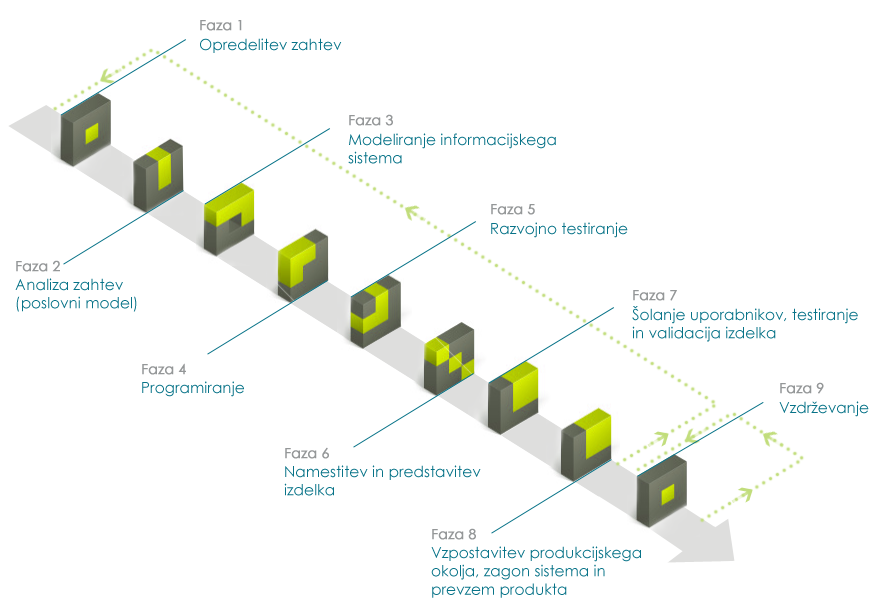Agile Software Development Life Cycle
Development methodology of RC IRC software project management encompasses the whole life cycle of software products, starting with customer demands, delivery of the product, live operation at the customer and the maintenance of the products.
It is a well managed and disciplined process approach, that enables us an uniform and efficient project management when it comes to development and maintenance of software products, thus reducing project risks and enabling better control over project expenses.
|
Agile Software Development Life Cycle
Phase 1: Definition of demands
The project group together with the customer specifies and adjusts the details of the customer demands, and prepares the launch concept of the project. The more general and vague contract demands are specified in detail and adjusted with the list of practically feasible functionalities.
Check point – CP1: Verification and validation of specified demand details and the launch concept of the project.Phase 2: Demand analysis (business model)
Project group analyses the demands, defines the business model, prepares the final document of the analysis and presents it to the customer, who verifies and validates the results and the business model.
Check point – CP2: Review, verification and validation of the final document of the analysis.Phase 3: Modeling of the information system
The objective of this phase is the making of the data model and the entity model (optional), as well as the preparation of instructions for programming and testing.
Check point – CP3: Verification of the information system model. Verification of the testing plan.Phase 4: Programming
The objective of this phase is to program and develop the software units in accordance with demands. The software units are tested independently and in assembly, the results are recorded in internal IRIS system.
Check point – CP4: Programming verification. Test results verification.Phase 5: Development testing
The objective of this phase is testing in concordance with the Testing directives (the test is successful when all the application data is applied in the form of correct results on appropriate screens and/or print outs). The result of phase 5 is a tested product, ready for installation at the customer.
Check point – CP5: Functional testing of the whole module. Control and verification of the product compliance with customer demands.Phase 6: Installation and presentation of the product
The objective of this phase is the transition from the development, pre-operational environment to the operational environment, as well as the presentation of the product to the customer via the presentation material. The result of phase 6 is the installation of the product in the customer testing environment and the presentation for the users in concordance with the presentation program (organizational, technological, content, data, human resource, and time aspects).
Check point – CP6: The verification of product installation at the customer. The verification and validation of the presentation material. Verification of the presentation for users in concordance with the program.Phase 7: Educating the users, testing the acceptability and validating the product
The objective of this phase is educating the users, and user testing the acceptability of the product. The requirements for this phase are an appropriate educational environment and testing environment at the customer, as well as a working product, test data and product documentation (user, help, technical, administrator). The results of phase 7 are educated and qualified users, and a tested, validated and formally accepted product.
Check point – CP7: Verification of the educated users qualification. Verification of testing and a record of product acceptance.Phase 8: Establishment of operational environment, start up of the system and ownership transfer of the product.
The objective of this phase is the establishment of an operational environment, data migration (optional), product ownership transfer, and operation start up. The results of phase 8 is an established operational environment, proper system functioning, a functional product, the IRIS objectives must have a customer approved status.
Check point – CP8: Verification of system function (operational functionality). Accepted product testing (verification and validation). Working product with transferred ownership (customer approved).Phase 9: Maintenance
The objective of this phase is the product maintenance, including horizontal add-ons and vertical upgrades of the standard product. The content of this phase is troubleshooting, recording of demands for changes or modifications of the system, improving performance, help with system use, and customer notification of program modules changes.
Check point CP9: Verification of operation and availability of the system. Versioning verification. Verification and validation of appropriately executed service in concordance to the maintenance contract. Change management verification (communication and notification) through web based Help-Desk.
|
The above description of the RC IRC development methodology is presented in a simplified , yet understandable and clear manner. The methodology is described in further detail in the Description of software development and maintenance project management process phases (model »A«), and the maintenance, add-on and upgrade of software products (model »B«). It depicts a new and improved development and maintenance project life cycle, as they are executed in RC IRC Celje. The development of products is described in model »A«, and the maintenance of products in model »B«.
Both aforementioned core processes are comprised of project phases, that include execution of primary, support and organizational processes, that are compliant with the demands of the Base Process Library (BPL) of TickIT plus, in all core characteristics. Both in-house models »A« and »B« describe the primary (IT/SW) Type B processes, as well as support and organizational (IT/SW) Type C processes.

